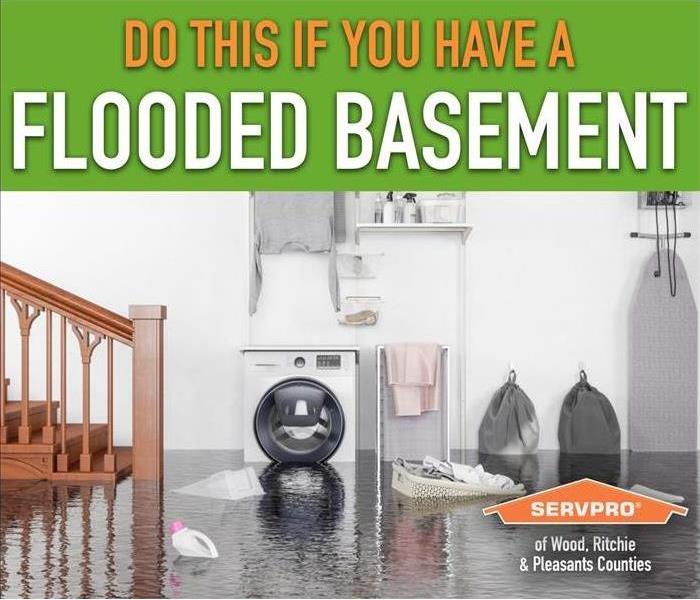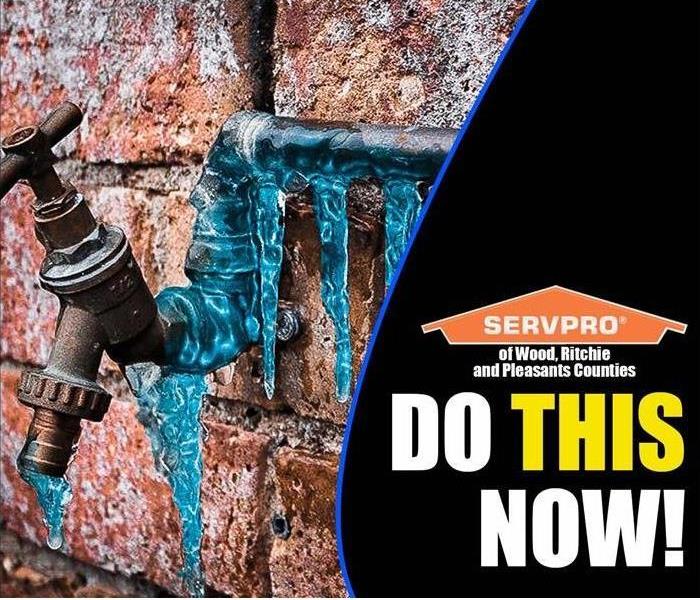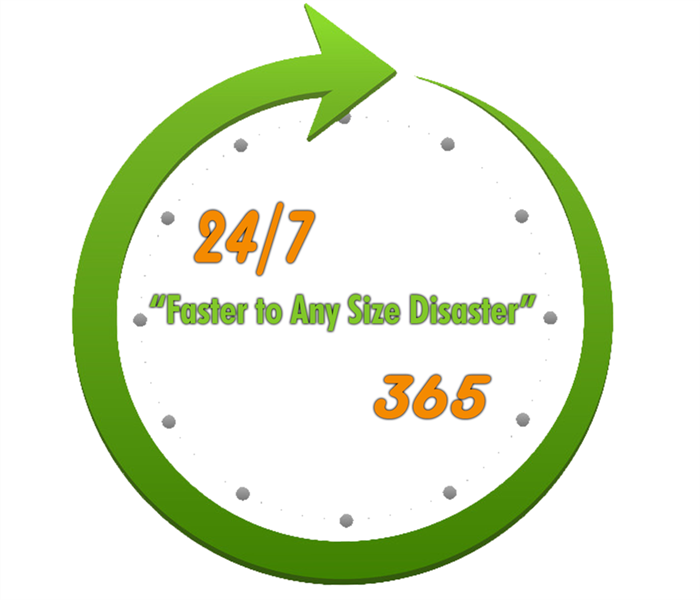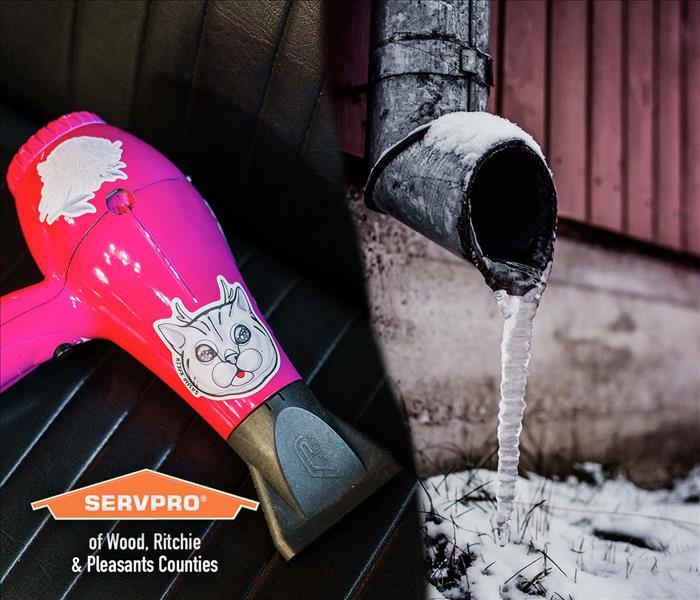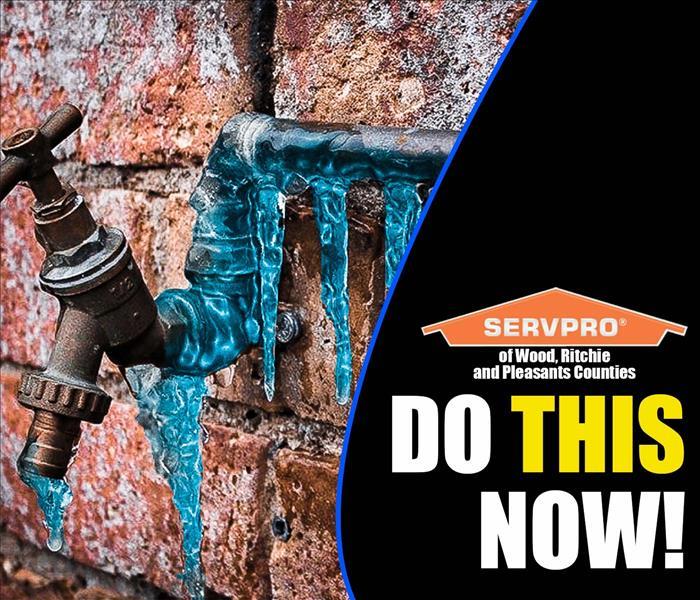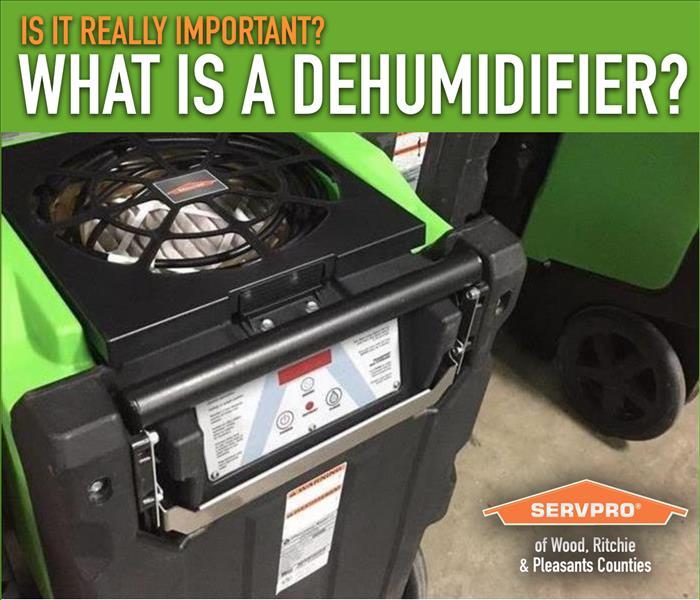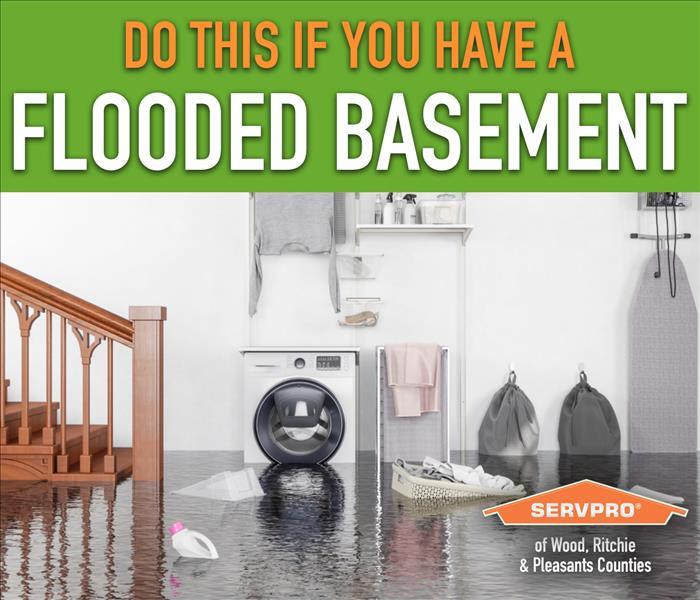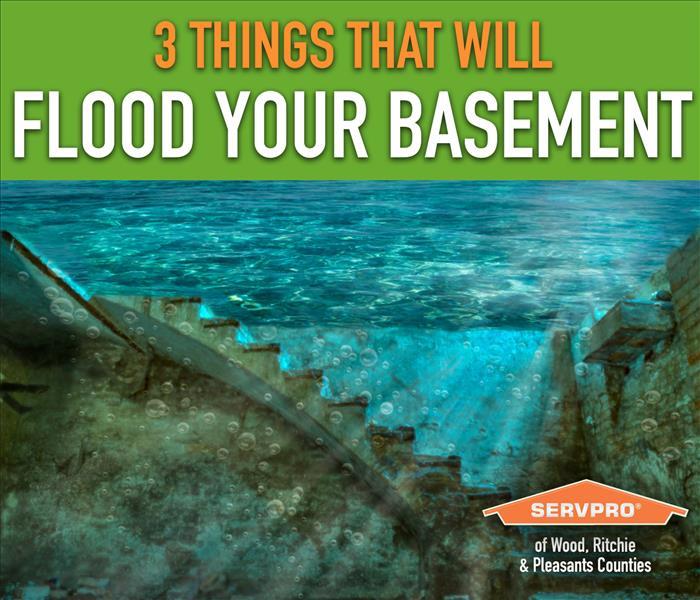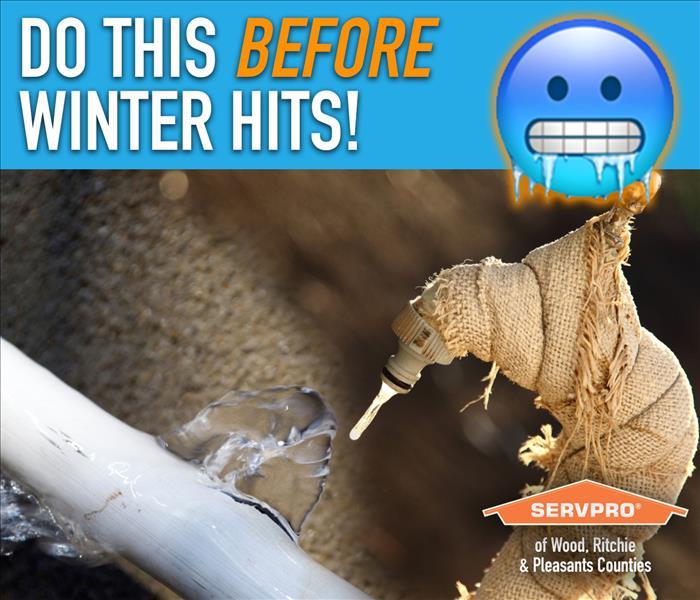Archived Water Damage Blog Posts
Avoid water damage
10/29/2024 (Permalink)
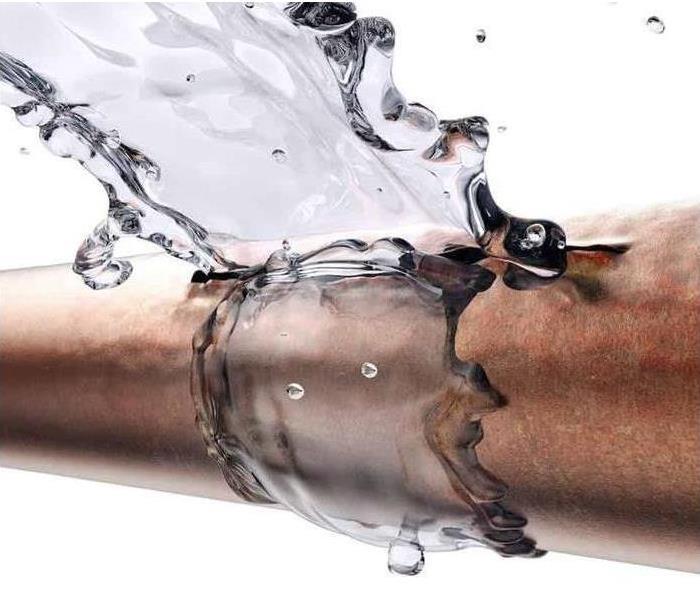 Avoid water damage
Avoid water damage
Here are three ways to avoid getting water damage in your home.
Tip #1: Clean gutters and downspouts.
Clean your gutters at least twice a year to avoid blockage. Sometimes you may need to clean more frequently.
Tip #2: Know Where Your Water Main is.
Plumbing experts say that the water main shutoff may be the most important plumbing feature in the entire house. So understanding where it is incase of emergency will help you in a situation where you need to shut it off.
Tip #3: Investigate & Fix leaks promptly.
If you see a leak, or evidence of a leak, do not wait to investigate it. Waiting could lead to much bigger problems down the road. You will want to make sure you fix it promptly.
4 Steps if your basement floods
9/6/2023 (Permalink)
Article at a glance:
- Common causes of basement flooding
- What to do if your basement floods
If the worst case does happen, what can you do to save thousands in water restoration and keep your family safe? Follow SERVPRO’s simple guide to keep your belongings and family safe.
4 Things To Do When Your Basement Floods
- Shut Off Electricity - Shut off electricity immediately. Not only will this keep your family safe, but will save you thousands in appliance replacement once the water has been cleared. SAFETY TIP: If you are wet or in water, DO NOT attempt to turn off the electricity because this is an electrocution risk. Remove yourself and anyone else from the premises and wait for emergency services.
- Find The Source - If it is safe to do so, enter your basement in protective clothing and locate the source of the flooding water. This might be an open window, or clogged drain.
- Start Removing The Water - If the damage is minimal, begin removing water with towels or a wet vacuum. This will help remove the bulk of the water, and fast track you to removing excess moisture in your basement.
- Get The Air Moving - Once the water has been removed, and flooding has stopped, open windows and doors to begin circulating air through your basement. This will help remove any leftover moisture, and stop any further damage to your belongings.
We hope that this has helped and you have found value. If you have any further questions regarding professional water removal and water damage restoration please call us on 304 428 7378 or click here to contact us.
The Team at SERVPRO of Wood, Ritchie & Pleasants Counties.
Read Further:
How to Check Your Sump Pump (SERVPRO owner’s sump pump almost didn’t work!) - Video
Shave Thousands Off Your Storm Bill
Frozen pipes could cost $1,000's in damages!
9/6/2023 (Permalink)
As winter rolls out SERVPRO is called because West Virginian families have sustained water damage in walls or even flooding because of a frozen spigot. This can cost anywhere from a few thousand dollars up to tens of thousands of dollars in restoration fees.
3 PRE-CAUTIONS TO DO BEFORE WINTER HITS
- Disconnect your hose: Do this step in Fall. If you’re reading this after, do it now! When a hose is connected it holds a small amount of water and this water freezes and expands in the hose, blocking it. This can cause a leak or even a burst pipe down the line.
- Use an Outdoor Faucet Cover: This is the next step and a lesser thought of one. Disconnecting your hose is one thing, but does not make your spigot winterized just yet. Most hardware stores supply outdoor faucet covers and are relatively inexpensive. A small step to take, a large headache avoided.
- Install a Frost-Free Faucet: This is the more permanent solution of the three and a highly recommended one. As the name suggests, this is a faucet designed to survive in freezing conditions. HOWEVER: it is still very important that you disconnect your hose during the Fall. While the frost-free faucets are a great solution, they are not 100% fail-safe. The water trapped in the hose can still be at risk of freezing, expanding and ultimately damaging the faucet, or creating further water damage.
WHY DOES THIS EVEN MATTER?
When the tip is frozen it creates a blockage. When any water tries to flow through the pipe it builds up and can burst a pipe, flooding the walls, the basement or anywhere else the pipes lead through the home.
WHEN DO THESE BURSTS OCCUR?
They can happen in the winter or leading into spring. When this happens it is common that the family does not notice the problem until Spring! Weeks to months later. Which means that any water damage has become much, much worse. Yes, this means more money for remediation. So please, do not forget to disconnect your hose.
Watch THIS video:
Watch this short, informative video that will illustrate the where the water causes the most damage.
Click here to watch
Keep safe and enjoy the holidays!
The Team at SERVPRO of Wood, Ritchie & Pleasants Counties
3 Tips on Avoiding Water Damage to Your Home
6/1/2022 (Permalink)
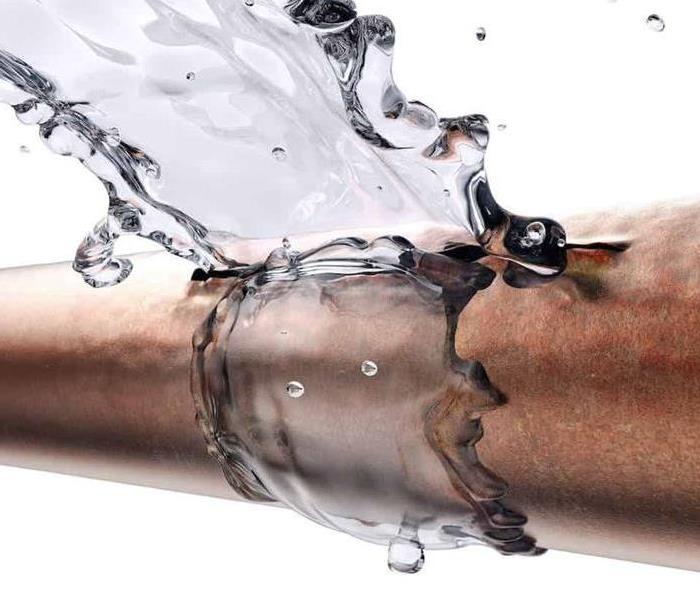 Pipe bursting from damage.
Pipe bursting from damage.
Here are three ways to avoid getting water damage in your home.
Tip #1: Clean gutters and downspouts.
Clean your gutters at least twice a year to avoid blockage. Sometimes you may need to clean more frequently.
Tip #2: Know Where Your Water Main is.
Plumbing experts say that the water main shutoff may be the most important plumbing feature in the entire house. So understanding where it is incase of emergency will help you in a situation where you need to shut it off.
Tip #3: Investigate & Fix leaks promptly.
If you see a leak, or evidence of a leak, do not wait to investigate it. Waiting could lead to much bigger problems down the road. You will want to make sure you fix it promptly.
Open 24/7: Help when you need it
3/9/2022 (Permalink)
At SERVPRO of Wood, Ritchie & Pleasants Counties we know that accidents never happen at a time that’s convenient. Water damage always occurs when you least expect it. It’s usually at the worst times when you’re out of town or even in the middle of the night. We are open 24/7 to help. No matter what time it is, give us a call.
We understand that water damage in your home can be overwhelming, leaving you feeling stressed and even fearful. Having a water restoration expert walk you through the process, can lessen the anxiety of the water disaster.
What to expect:
When you call, we will ask several questions regarding your water damage emergency. These questions will help us determine what equipment and resources to bring, including how many trained SERVPRO Professionals may be needed.
Our SERVPRO Representative will ask several questions:
- Your name and contact information
- Your insurance information (if applicable)
- The street address of the water-damaged home or business
- When did the flooding or water damage occur?
- What caused the water damage (if known)?
- Is there electricity available (on-site)?
SERVPRO of Wood, Ritchie & Pleasants Counties is always "Faster to Any Size Disaster"
Give us a call today-We're always here to help.
304-428-7378
How to Safely Thaw a Pipe (PLUS Something You Should Seriously Avoid)
11/29/2021 (Permalink)
With Fall coming in fast, there’s no denying it is getting cold in Wood County! So this is a little reminder that if you’re pipes are starting to freeze it’s important to correctly thaw them otherwise you may be putting your pipes at risk of cracking. A cracking pipe can create much bigger problems.
1. Turn off the Water Supply
Turn off the water supply to the section of the house where the frozen pipe is. If this isn’t possible, turn off the entire house. This is because frozen water may be acting as a plug, backing up the water, putting pressure on the pipes, risking a burst or crack.
2. Have a mop, bucket at towels on the ready
This is just in case of a leak. At times there may be a leak (minor or major) and it’s important to catch the water before it goes too far and wide.
3. Use a space heater, heat lamp or hair dryer
Using these appliances will help the pipe to slowly, and safely thaw out. It’s important to avoid using a propane torch because the propane torch can be a high risk for fire.
[Another option]
Wrapping the pipes with thermostatically controlled heat tape (prices range from $50 to $200, depending on the length you’re needing) is a really neat and effective way to thaw out frozen pipes (but more pricey than the methods in point 3.
We hope this has helped. Keep safe this fall and winter and a happy thanks giving from the team at SERVPRO of Wood, Ritchie & Pleasants Counties.
Related Topics:
A frozen pipe can cost you $20,000 in Damages ** do this FREE thing BEFORE winter **
How a small amount of water in your home can create a major health hazard (and how to resolve it)
A Frozen Pipe Could Cost you $20,000! *Do this FREE thing BEFORE winter*
11/3/2021 (Permalink)
As winter rolls out SERVPRO is called because West Virginian families have sustained water damage in walls or even flooding because of a frozen spigot. This can cost anywhere from a few thousand dollars up to tens of thousands of dollars in restoration fees.
3 PRE-CAUTIONS TO DO BEFORE WINTER HITS
- Disconnect your hose: Do this step in Fall. If you’re reading this after, do it now! When a hose is connected it holds a small amount of water and this water freezes and expands in the hose, blocking it. This can cause a leak or even a burst pipe down the line.
- Use an Outdoor Faucet Cover: This is the next step and a lesser thought of one. Disconnecting your hose is one thing, but does not make your spigot winterized just yet. Most hardware stores supply outdoor faucet covers and are relatively inexpensive. A small step to take, a large headache avoided.
- Install a Frost-Free Faucet: This is the more permanent solution of the three and a highly recommended one. As the name suggests, this is a faucet designed to survive in freezing conditions. HOWEVER: it is still very important that you disconnect your hose during the Fall. While the frost-free faucets are a great solution, they are not 100% fail-safe. The water trapped in the hose can still be at risk of freezing, expanding and ultimately damaging the faucet, or creating further water damage.
WHY DOES THIS EVEN MATTER?
When the tip is frozen it creates a blockage. When any water tries to flow through the pipe it builds up and can burst a pipe, flooding the walls, the basement or anywhere else the pipes lead through the home.
WHEN DO THESE BURSTS OCCUR?
They can happen in the winter or leading into spring. When this happens it is common that the family does not notice the problem until Spring! Weeks to months later. Which means that any water damage has become much, much worse. Yes, this means more money for remediation. So please, do not forget to disconnect your hose.
Watch THIS video:
Watch this short, informative video that will illustrate the where the water causes the most damage.
Click here to watch
Keep safe and enjoy the holidays!
The Team at SERVPRO of Wood, Ritchie & Pleasants Counties
How a Small Amount of Water In Your Home Can Create a Major Health Hazard (and how to resolve it)
4/12/2021 (Permalink)
Water is invasive and silent. It can sit inside your carpet and other furniture, a bring life. But sometimes to the type of life that poses potential health effects.
Mold.
Mold and Black Toxic Mold can grow from a very small amount of moisture in the air. This is where it becomes a problem.
Feeding ground.
Mold and Black Toxic Mold release spores into the air. These spores, when inhaled, can create health effects.
Take action.
Some moisture is necessary in the air, but in highly humid areas, it’s important to release the moisture. Areas that are highly prone to humidity include the bathroom, laundry and some basements.
Release the moisture.
Open the windows or turn on an exhaust fan and let the moisture out. When it can escape, it will. The moisture wants to get out of the house and into the atmosphere. Let it.
Wipe down the excess.
At times the moisture creates condensation on the walls. Wipe this down as soon as possible so that the water cannot seep into the materials and create a mold-breeding environment.
Use a Dehumidifier.
If you cannot do the two, try this option. Dehumidifiers sell at some home shops or Home Depot, but don’t be sucked in by the cheap ones because some of them don’t clear our the moisture, they just clear out your wallet.
Find out some more information.
Black Toxic Mold: Avoid Having this Risk In the Family Home
Dehumidifiers: Why are they better?
What is a Dehumidifier and Why Is It Better?
4/5/2021 (Permalink)
Dehumidifiers are an important piece of equipment used in the drying process of water damage restoration, but why? Is it really necessary or just a big piece of equipment to look fancy?
The Silent Killer - Water
Where fire is obvious, water can damage your items in silence and slowly, until it’s too late. Unlike fire, water comes in different forms that cause damage; liquid and vapor, and when left alone, they allow for mold growth as well as other issues, such as erosion of your structures.
Even after the obvious water has been removed, there is still humidity (water vapor) in the air. This vapor creates a breeding ground for mold, and also the opportunity to shift into water and damage furniture.
This is Why Dehumidifiers are Used
As the name suggests, the dehumidifiers remove the humidity (and moisture) from the air and other materials.
By removing the moisture, your furniture and other items are significantly less likely to be vulnerable to mold growth.
If you ever need any questions answered, or need help with fire, mold, storm or water damage, please call your local team at SERVPRO on 304-428-7378 or contact us on our contact page.
From the team at SERVPRO of Wood, Ritchie & Pleasants Counties.
Do THIS Easy and Free Trick to Avoid Expensive Gutter Collapse this Winter
3/1/2021 (Permalink)
The Mid-Ohio Vally has been hit by an excessive amount of snow the past two weeks and homes are falling prey to roof and gutter collapses all around the area as a result.
If you haven’t already; make sure to do this simple trick to help rid your roof and gutters of snow build up.
Why Does the Gutter Collapse?
When snow builds up in your gutters some of that snow temporarily melts, becomes water, and then solidifies to ice. This allows more water (ice) to fill up your gutters and create a much heavier unit that sits in your gutters.
Your Gutters are not Build to Hold That
Gutters are only built to temporarily hold water before it streams down the pipes. So when it has weight for extended periods of time, it weighs down the gutters and joinery, pulling them off.
They Pull the Walls and Roof Too
It’s rarely a clean rip. The gutters don’t just come off, they bring the walls, tiles and supports with them; potentially creating holes in the roof, or walls, letting snow and water into your home. This becomes much more expensive in the remediation process because now you have to restore outside, inside and the supports. Not to mention water damage and possible mold growth too.
DO THIS: Throw Your Pantyhose on the Roof
This cheap and simple trick is well known, but perhaps not completely understood. But knowing why you’re doing it, will help you know where is the best place to throw them.
Step 1: Fill some old pantyhose (or even buy new, they’re quite affordable) with salt or calcium chloride then tie up the end tightly so that it’s like a ball of salt in the foot of the pantyhose.
Step 2: Fling the pantyhose onto the roof at different heights. The higher the better (we’ll explain why in the next section).
Step 3: If possible, keep an eye on the pantyhose because you may need to throw some more up later to replenish.
Why does this work?
First we must know the freezing points for both water and salt water. Water has a freezing point of 32ºF where as salt water freezes at 28.4ºF. This difference is all the reason! … huh?
Ok, so when the snow melts slightly, the salt in the pantyhose mixes with the water, creating salt(ish) water. Now, it requires a lower temperature to freeze. This difference means that the snow will take longer to freeze, allowing it time to escape down your drains and not stay in the gutters.
Wrapping it up:
So there you have it, fling up those salty pantyhose so the water and snow takes a little longer to freeze, and you will minimise the chance of ice freezing in your gutters.
We hope this helped. If you have any further questions or would like some tips, please do not hesitate to call us on 304-428-7378 or email us on this page —> click here.
From the team at SERVPRO of Wood, Ritchie & Pleasants Counties
What To Do If Your Basement Floods (4 Steps)
11/23/2020 (Permalink)
Article at a glance:
- Common causes of basement flooding
- What to do if your basement floods
If the worst case does happen, what can you do to save thousands in water restoration and keep your family safe? Follow SERVPRO’s simple guide to keep your belongings and family safe.
4 Things To Do When Your Basement Floods
- Shut Off Electricity - Shut off electricity immediately. Not only will this keep your family safe, but will save you thousands in appliance replacement once the water has been cleared. SAFETY TIP: If you are wet or in water, DO NOT attempt to turn off the electricity because this is an electrocution risk. Remove yourself and anyone else from the premises and wait for emergency services.
- Find The Source - If it is safe to do so, enter your basement in protective clothing and locate the source of the flooding water. This might be an open window, or clogged drain.
- Start Removing The Water - If the damage is minimal, begin removing water with towels or a wet vacuum. This will help remove the bulk of the water, and fast track you to removing excess moisture in your basement.
- Get The Air Moving - Once the water has been removed, and flooding has stopped, open windows and doors to begin circulating air through your basement. This will help remove any leftover moisture, and stop any further damage to your belongings.
We hope that this has helped and you have found value. If you have any further questions regarding professional water removal and water damage restoration please call us on 304 428 7378 or click here to contact us.
The Team at SERVPRO of Wood, Ritchie & Pleasants Counties.
Read Further:
How to Check Your Sump Pump (SERVPRO owner’s sump pump almost didn’t work!) - Video
Shave Thousands Off Your Storm Bill
3 Things that will FLOOD your Basement (and how to Avoid it)
11/16/2020 (Permalink)
Article at a glance:
- 3 things that cause basements to flood
- How you can avoid spending thousands on basement flooding
It’s too often that homeowners are met by murky water when they enter their basement. Water build up and other factors make the lowest point of your home an easy target for flooding.
3 Things That Cause Basement Flooding:
- Insufficient Drainage - Water needs to escape. Otherwise water will build up around your basement walls. If not fixed quickly this water can become heavy enough to break through. Your basement is the lowest part of your home, therefore all excess water is highly likely to flow down to your basement as a result of poor drainage.
- Faulty Sump Pump - This pump could mean the difference between catching a flood right as it starts, or spending thousands on restoration work. A sump pump is triggered automatically when water enters your basement. This little guy (or gal) could save your belongings and your pockets. Be sure to routinely check your sump pump because if it isn’t, this season might be very expensive.
- Heavy Rains - Unfortunately for most, cracks or bad drainage is found out after the damage has occurred. Heavy rains are the most common cause of basement flooding, and make your insufficient drainage a nightmare when it’s too late. Heavy rains mean excess pooling around the foundation of your home, and make your basement an easy target.
We have put together some tips to help you avoid basement flooding (and the huge bills that come with it). Follow our simple steps to keeping your home flood free.
3 Tips To Avoid Basement Flooding:
- Clear Gutters - A simple way to keep your basement safe is by regularly checking your gutters for any clogs. Ensuring the gutters are working efficiently means you can avoid any water pooling around the foundations of your home.
- Check Your Pumps - Don’t just pay attention to your pump when it starts to rain. Check it throughout the year to ensure it is in working condition. Having a machine that automatically pumps out water will save you thousands by keeping your belongings dry and out of a pool of water.
- Always Close The Window - So simple, but so easily forgotten. Too often we see homes that have flooded because of an open basement window. Pooling around the window may result in water flooding into your basement, and catching electrical on its way down. When the rain starts, triple check your windows are closed and not at risk of breaking.
We hope that this has helped and you have found value. If you have any further questions please call us on 304 428 7378 or click here to contact us.
The Team at SERVPRO of Wood, Ritchie & Pleasants Counties.
Read Further:
Types of Water Damage
How to Check Your Sump Pump (SERVPRO owner’s sump pump almost didn’t work!)
How To Avoid Thousands In Damages From West Virginia Storms
How to Avoid Frozen Pipes This Winter (MUST do This BEFORE Winter Comes)
9/28/2020 (Permalink)
Article at a glance:
- 2 Reasons You Don’t Want Frozen Pipes in Your Family Home
- 3 MUST DO things for your Indoor Pipes
- 1 MUST DO and two optional things for your Outdoor Spigots
Frozen pipes costs West Virginian families hundreds of thousands of dollars in damages each year. A burst pipe can lead to a flooded basement, which leads to a potential insurance bill of over $20,000. Your actions can avoid this happening to your family home by doing some very simple actions.
First, let’s understand what can come from a frozen pipe. Don’t skip to the next section or you might miss some important information.
- NO RUNNING WATER. Frozen pipes mean your faucet trickles, instead of a nice flow. This can be financially dangerous as time goes on. Each time you turn on the water, the water might be backing up in the pipe and seeping into the supporting walls. Damaging them slowly and/or providing an environment for mold to thrive.
- EXPLODING PIPES. When our pipes freeze, a significant amount of pressure can build up between the faucet and blocked pipe. When this continues to increase, the likelihood your pipes are going to explode continues to increase. This explosion wreaks havoc in your home, from the basement to the supporting walls.
You do not want this inconvenience to happen to you or your family. This remediation process can be not only expensive but timely too. By following this checklist you will be able to dramatically minimize the likelihood of water damage from frozen pipes in your home.
- Keep your home warm. Turning up the heat in your house can do wonders for the pipes hidden in your walls or floors. Allowing heat into usually cold rooms will help the pipes stay frost free all winter long.
- Leave doors open. If you have pipes under sinks, or exposed pipes in your cabinetry, leave the doors open. This will help warmer air circulate around the pipes, and keep them warm.
- Switch off the water. This one is vital! Doing something as simple as turning off an unused water supply to your garden can help your outdoor pipes and hoses stay defrosted. Try to get into the habit of switching your water on outside only when you need it.
CLICK HERE TO READ:
3 Simple Steps to Avoid Up to $10,000 in Damages from a Frozen Spigot
It is important to note that once pipes burst you will need professional assistance. If the worst case happens, be ready with towels and tape to temporarily slow the flow of water while you wait for the experts. If you notice any signs of frozen pipes such as slow water, follow our tips or reach out.
If you have any further questions please call us on 304 428 7378 or click here to contact us.
The Team at SERVPRO of Wood, Ritchie & Pleasants Counties.
Related Articles:
WATCH NOW: Avoid $10,000 in Flooding Damages in Under 2 minutes
Sublimation - Why it is the Best Way to Dry Vital Documents?
4/13/2020 (Permalink)
 Be very careful what you do when drying documents
Be very careful what you do when drying documents
How do you dry Vital Documents? Do you have some vital documents that have just been ruined or dampened by water? Are you concerned that this information may be lost? Are you hoping it’s salvageable?
Sublimation is the process of making water transform directly from solid (ice) straight to gas (condensation or air). It skips being liquid water entirely.
Skipping being liquid is extremely important because it can re-damage the documents when thawed. This is because the water can streak the ink or pull apart the paper or material.
Sublimation is approved by the National Archives and Records Administration and General Services Administration.
Do This First to Your Wet Documents
Freeze them immediately:
Freezing halts the destruction of the paper. It won’t undo any damage but it will press the pause button because bacteria and mold cannot grow on it when in a freezing environment.
This will work on wet client files, wet family photos or wet posters. Be careful with the documents. If possible lie them flat and separated.
If SERVPRO of Wood, Ritchie & Pleasants Counties is required we will transport the paper in its frozen state to our document restoration centre.
SERVPRO Document Restoration Services - Beyond Drying
In addition to simply drying documents our Documentation Restoration Services we can decontaminate and digitize.
Document Decontamination: Sometimes documents can be exposed to hazardous conditions such as a sewage spill. In these instances it is very important that the contaminants are cleared, while still keeping papers in tact as best as possible. SERVPRO can provide this.
Digitization of Documents: Back up files are important. All salvageable documents can be digitized as a back up if you or your office wishes to do so. This will help avoid any future issues and an optional service.
Most importantly, we and all members of the document restoration team are HIPPA Master Certified, which means that patient records and private information are in a secure chain of custody while they are being restored.
If you have any further questions please do not hesitate to call SERVPRO of Wood, Ritchie & Pleasants Counties on (304) 428 7378 or click here to contact us now.
How to Fix a Seized Sump Pump: This Simple Act Could Save you Thousands of Dollars in Damages
3/9/2020 (Permalink)
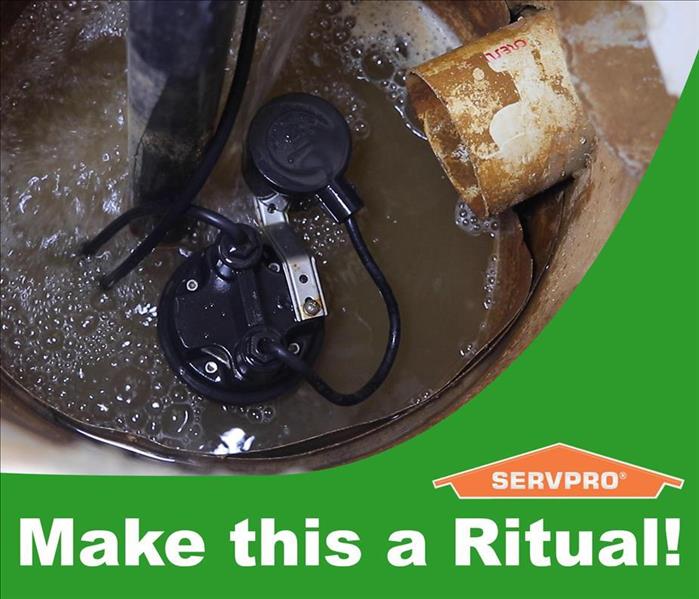 This Sump Pump is About to Flood the Basement!
This Sump Pump is About to Flood the Basement!
A seized up Sump Pump can cost a home owner thousands upon thousands of dollars in damage. Some of this can be unrecoverable (unique items that cannot be replaced by money).
Imagine the time and money it would take to repair a flooded basement. Would it be worth it when you know it could have been avoided by one simple, routine check a year? Definitely not.
Each year during winter our team at SERVPRO of Wood, Ritchie & Pleasants Counties are called with families and business owners that suffer avoidable basement flooding from seized up Sump Pumps.
This is easily avoidable with one routine check each year. This takes merely minutes.
First we will briefly explain what a sump pump is and why it is important. If you already know what it is, please jump to the next heading.
What is a Sump Pump?
A sump pump removes excess water in a water-collecting sump basin and are typically found in basements.
A sump pump often is used to drain water from the perimeter drains of a basement waterproofing system. It funnels water that is above the foundation of the house away from the home into a municipal storm drain or dry wall.
Why do a Routine Check for you Sump Pump?
Sump Pumps are known to seize up during the summer because the are not typically used then. This becomes a problem in the winter months when excess water is drained into the sump pump.
When the sump pump is seized up the excess water is very likely to build up fast in the sump pump drain and overflow into the basement.
Now, because the sump pumps primary job is to remove excess water from the basement you now effectively have a plug in the sump pump. The flood water only continues to rise.
No you have a real problem.
How to Check for a Seized Up Sump Pump
Checking to see if your sump pump has seized up is very simple and should be a routine each year, around a month before the winter months.
Step 1: Locate your Sump Pump The sump pump is often found in one of the corners of the basement. It will be a pump leading into a hole, often covered by a black lid.
Step 2: Make sure that the sump pump is turned on Sound silly, but this is a very important part.
Step 3: Pour some water into it Your primary goal is to make sure that your sump pump has not seized up over the summer months. If the water continues to build up with no display of the water being pumped away you may have a seized up sump pump.
Step 4: How to Unseize the Sump Pump Surprisingly this is usually done by a simple shake of the pipe and pump (see the video below for how). This will jolt the sediment build up allowing for the sump pump to pump freely.
Step 5: Test Two More Times Once the water begins to pump out through the sump pump, it's important to test two more times to fully clean out the sump pump.
Fill the hole up a few more times and allow the sump pump to do what's it's made for ... to pump water. This is important to make sure that the sediment won't build up in the next few months.
Final Step: Watch the Video Our co-owner, Steven Seckman, was demonstrating how to do this and realised that his own sump pump had seized up.
Even our owners sometimes forget! Luckily he may have avoided the water damage. You will learn from his lesson brought unto himself and further see how easy it is to fix a very expensive problem before it happens.
Click here to View the Video
We hope that this blog post has been helpful. If you could share this on your social media pages that would be a huge help to spread the word so that others can avoid the painful flooding of a basement.
From the team at SERVPRO of Wood, Ritchie & Pleasants Counties
Silent Water Damage: 3 Things You Should Know About This Secretive (and Expensive) Damage
2/25/2020 (Permalink)
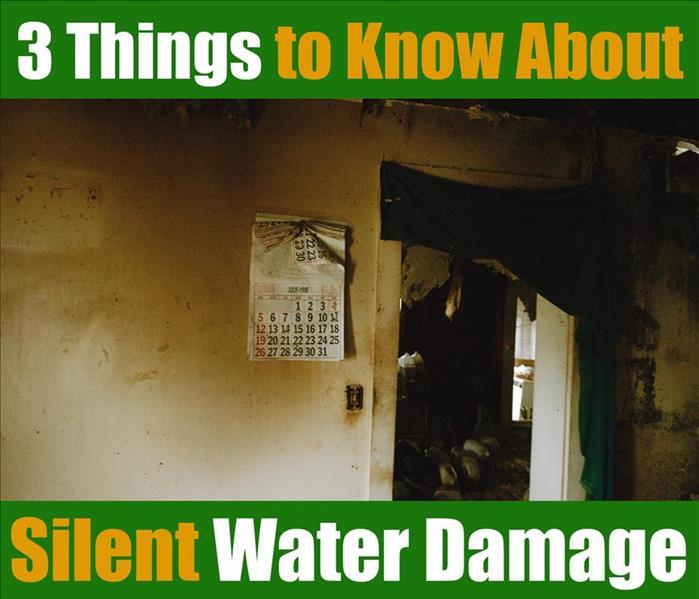 This is an example of extreme water damage coming to the surface. Don't wait until it's too late.
This is an example of extreme water damage coming to the surface. Don't wait until it's too late.
Severe water damage is mainly done over time. Water is a silent killer of your home foundations, furniture, air quality and anything else in it’s path (think of your finger tips when they’re in water too long!).
It is not so much about the water you can see, instead the water you don’t. After the visible water is cleared water remains in the cracks, crevices and underneath items, slowly eroding everything it touches. This is called Bound Water.
When looking at a house in Harrisville, WV our team noticed that there were multiple areas of water damage that had slowly built up over time. The family never had a flood or major water leak, instead it was gradual, small water leaking that had caused some major foundation damage.
Why Does Water Damage Building Foundations So Easily?
Water erodes dirt and soil under, around or in concrete and other materials in three main ways:
- Through movement - small, minor movements and friction slowly erodes the concrete (think about how crevices are carved in rocks from a stream of water).
- Through expansion - water expands within wooden foundations and furniture. By expanding within the wood, it breaks the wood apart, ruining is structural integrity.
- Through oxidation - As water comes into contact with metals (in the foundations, furniture or electrical equipment) it creates oxidisation, creating rust. Water doesn’t have to be a liquid. Even as condensation it can create rust in foundations and important household items.
How Do You Avoid This Silent Water Damage?
Prevention is always better (and cheaper) than cure. The earlier you catch issues, the better.
Create a routine of checking your basement and foundations. Perhaps every two weeks. This check will only take you a few minutes but could save you tens of thousands of dollars!
- Look for any leaks. e.g. plumbing fixtures and drains.
- Feel for any dampness around pipes and fixtures.
- Smell for any musty smells (indication of mold growing - therefore dampness)
If something catches your attention, find where the source of the water or dampness is coming from. If you can cut this off immediately (and safely) then do so and thoroughly clean up of all water you can see.
Had the family is Harrisville, WV known of this simple step they could have avoided costly repairs to the foundation and carpet replacement.
How Do You Fix Silent Water Damage?
It’s obvious to say: thorough water eradication is necessary. Water removal techniques include heat, air and sanitisation (don’t forget the potential for mold growth).
Silent water damage may require structural and foundation repairs as well as interior demolition and repairs. Common silent water damage normally consists of wood framing, drywall, insulation, trim, flooring and painting. It can also require exterior excavation and possibly pest control such as termite removal.
If you are unsure of any possible silent water damage please do not hesitate to call our team at SERVPRO on (304) 428 7378 and one of our technicians can assist you with further information.
We hope that this has helped.
Remember: set aside a few minutes bi-weekly to check for any silent water damage.
From the team at SERVPRO of Wood, Ritchie & Pleasants Counties
How to Determine If Your Home has a Mold Problem: The Air is the Concern
2/14/2020 (Permalink)
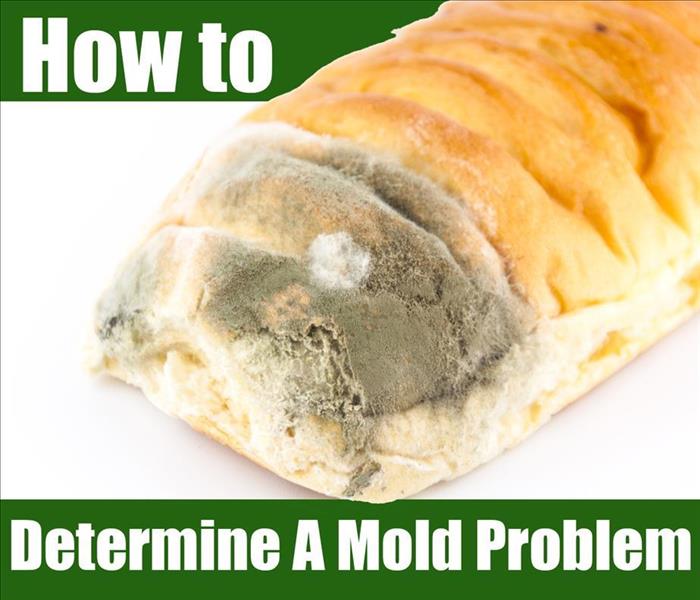 It's Not the Mold You See, It's the Mold You Don't
It's Not the Mold You See, It's the Mold You Don't
It’s widely known that mold can have health effects when in the home. Surprisingly it’s not the mold itself that is potentially dangerous, instead it’s the spores that fly in the air.
Mold is often present in homes in the Mid-Ohio Valley area. We often get calls regarding this in areas such as Parkersburg, WV, Harrisville, WV and other surrounding areas. Basically wherever there is water and moisture, there’s a strong chance of mold growth in the home.
Why is Mold Something to Be Aware Of?
Mold gives off microscopic spores that travel through the air. When inhaled it may cause some health effects and for this reason it is something we should all be aware of in our homes. The place where our families spend a lot of their time.
“Just because you can’t see it doesn’t mean it doesn’t matter.”
The spores travel through the air and can impact the air in your home even if the mold is not visible to you. Have you ever smelt a slightly musty smell? That’s mold. That’s the spores in the air. Don’t be too concerned just yet though; there are levels to this and some amounts are safe (our team can help answer that question in further).
Things to Know About Mold
- Mold is present everywhere. Whether it’s indoors or outdoors it will be present where there is moisture.
- Mold spores are pushed through the air from any air flow, whether it’s from natural wind, AC, doorways or anything like that.
- Mold spores thrive in moisture. The spores are the mold’s method of expanding the organism. When the spores land in moisture it allows them to grow into more mold. Keeping your home dry is very important to minimise mold growth.
- Mold spores create a musty smell in the air. This is the easiest method to detect mold in your home.
- High humidity helps grow mold. Humidity promotes moisture and this is ideal for mold growth.
How to Determine If Mold Is a Problem
Determining mold issues in your home is quite often simple but overlooked by homeowners. You just need to try these simple things:
- Is your home very musty? If it is very musty or “damp” in the air smell, then there is most likely a mold issue occurring.
- Can you see it? Sounds obvious and it is! If you can see mold growing, then there is a good chance that there is more mold growing underneath surfaces such as your dry wall. If you can see it, call someone immediately to have your questions and concerns answered. Do not ignore it.
- Are there damp areas in your home? Like we mentioned before, mold loves moisture. Therefore it’s important to check areas that are more prone to mold - examples include the shower, laundry and the basement.
Mold Removal Vs Mold Remediation: Which is Your Best Bet?
Most businesses advertise themselves as “mold removal” companies and often make claims of full mold removal. This is an utter lie that customers should be aware of. It’s not possible to remove mold 100% as we mentioned before. Mold is everywhere. It’s the level of mold that is important to track.
Mold remediation is what we always suggest. Mold remediation reduces the mold spore count in the air, taking it back to the natural (or baseline) level. This is in addition to the removal of mold that is present in the home.
Please remember though; our team at SERVPRO cannot guarantee 100% mold removal as that will be lying to our customers and to you. We will remove as much as possible, remediate the air to it’s natural and safe levels and make your home air quality safe again. We cannot promise it will not grow back because this is dependant on moisture levels in your home and in certain areas, some of which can be unavoidable.
We hope this has helped
The Team at SERVPRO of Wood, Ritchie & Pleasants Counties
If You Suspect Signs of Mold, Call Us Today – (304) 428 7378
3 Simple Steps to Avoid up to $10,000 in Damages from a Frozen Spigot
11/11/2019 (Permalink)
 A few small actions can save you thousands
A few small actions can save you thousands
As the winter months approach across America everyone is getting ready to warm themselves up. But there’s a common problem that we see in Vienna, WV and other surrounding areas; home owners are forgetting three simple steps to stop their spigot freezing over in winter. When spring comes around and they attempt to use their hose for the garden they are horrified to notice flooding and water damage in their home.
Frozen spigots can be the cause of thousands of dollars in damage to a home. We have seen a home in St. Mary’s, WV even experience $10,000 worth of water damage as a result of flooding and water damage. This was a very easily avoidable cost. By following these very simple (and often forgotten) steps to winterise your spigot, you can avoid an awful surprise in Spring.
The 3 Steps to Avoid a Frozen Faucet During Winter
- Disconnect Your Hose: Do this step in Fall. If you’re reading this after, do it now! This is important because when a hose is connected it holds a small amount of water. This water, when freezing, expands to the thickness of the hose and ultimately blocks it. When this happens the hose can leak or burst. The real damage comes from the backing up of the water when the tap is turned on. This break can even happen in winter. When this happens it is common that the family does not notice the problem until Spring! Weeks to months later. Which means that any water damage has become much, much worse. Yes, this means more money for remediation. So please, do not forget to disconnect your hose.
- Use an Outdoor Faucet Cover: This is the next step and a lesser thought of one. Disconnecting your hose is one thing, but does not make your spigot winterised just yet. Most hardware stores supply outdoor faucet covers and are relatively inexpensive. A small step to take, a large headache avoided.
- Install a Frost-Free Faucet: This is the more permanent solution of the three and a highly recommended one. As the name suggests, this is a faucet designed to survive in freezing conditions. HOWEVER: it is still very important that you disconnect your hose during the Fall. While the frost-free faucets are a great solution, they are not 100% fail-safe. The water trapped in the hose can still be at risk of freezing, expanding and ultimately damaging the faucet, or creating further water damage.
We hope that this has helped and will save you money.
Please share this blog post by sharing the link below on your Facebook.
https://www.SERVPROwoodritchiepleasantscounties.com/blog/post/179388/water-damage-restoration/3-simple-steps-to-avoid-up-to-10000-in-damages-from-a-frozen-spigot
For more tips on Water Damage click here.
Thank you from the team at SERVPRO of Wood, Ritchie & Pleasants Counties.
Doing this Simple Thing Can Save You Thousands of Dollars with Your Water Heater
11/4/2019 (Permalink)
 In Only An Hour or Two You Can Save Thousands of Dollars
In Only An Hour or Two You Can Save Thousands of Dollars
Water heaters are so important in our home. They provide warm showers, baths and clean our washing. Yet, so many home owners forget to do a simple flushing each year. This simple flushing and cleaning will help avoid the likelihood of a leak or burst, which can potentially cost thousands of dollars in water damage.
It’s Like Earning $1,000+ in a Few Hours
Think of it this way: If you don’t spend that money on fixing the water damage, you’ve ‘made’ that money. So by spending a few hours, doing what we will describe below, you will avoid the likelihood of a water heater leak or burst. Therefore … you’ve avoided spending $1,000+ on fixing it.
The Issue You Will Avoid
Besides leaks and/or bursts in your Williamstown home water heater, avoiding routine maintenance can also create problems such as low hot water supply, loud (and annoying) sounds as a result of overheating, faults in the heating mechanism or even clogged pipes. All these cost you money to fix. All these are avoidable. But how do you perform a flush? We will explain below.
How to Perform a Flush on Your Water Heater
There are two methods to do this:
- Difficulty = easy: This will cost some money (still a lot cheaper than fixing water damage); use your local plumber. A local plumber has expertise in this and will be able to promptly flush your water heater.
- Difficulty = Medium. Flushing it yourself. It is important to flush your water heater annually, and this will only take a few hours to do (probably not even that). This will be explained below:
Flushing it Yourself
Before reading this we at SERVPRO of Wood, Ritchie & Pleasants Counties only recommend that you do this if you are familiar with the steps provided. Also be sure to take all safety precautions seriously. If you’re not confident, please use a local plumber. If you’re confident, please keep reading.
- Turn off all gas and electricity to the heater.
- Turn off the water valve.
- Turn on the hot water in a nearby sink to release any pressure.
- Connect a garden hose to the faucet and release any water to a bucket and remove the water.
- Now, turn on the cold water and allow for the drainage of the tank. Continue until you have completely flushed the tank and the water is almost clear.
Why This Simple Flushing Will Decrease the Chance of Leaks or Flooding
This simple maintenance yearly will allow for any sedentary water to be removed. This will completely replace all water within the tank, also removing any bacteria build up in the water and allow for the pipes to be completely flushed out. (NOTE: For more detailed flushing and sterilisation we recommend using your local plumber). Furthermore it will reduce the likelihood of overflowing of the tank, which can lead to leaks or even bursts, resulting in flooding and water damage within your home. Water remediation is costly when compared to the other option of simple, yearly maintenance.
If the unfortunate event of a leak or potential water damage occurs, please do not hesitate to give us a call because if left too long, water damage exponentially gets worse over a short period of time. Please read our article regarding water damage steps for further information. While this article is about commercial buildings, the same principles apply with homes.
Please share this article on your Facebook. If you can help one friend save money that will be a huge help for them.
The team at SERVPRO of Wood, Ritchie & Pleasants Counties
How to Thaw a Frozen Pipe
11/27/2018 (Permalink)
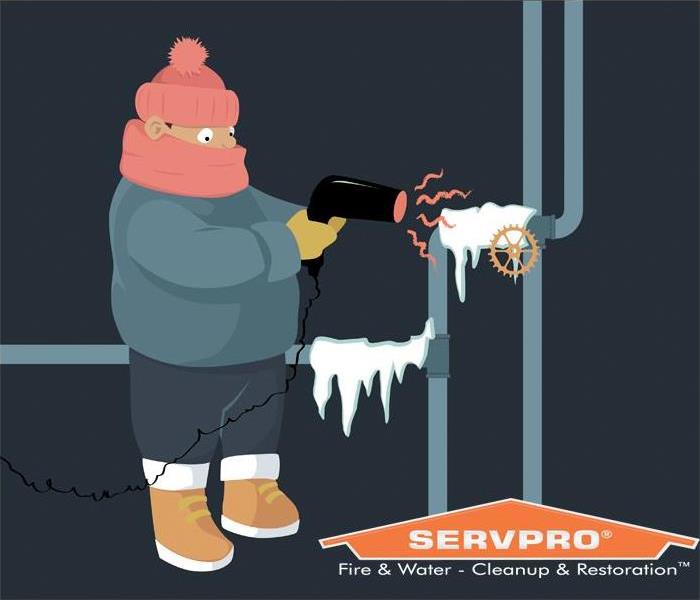 It’s not the frozen pipes that really gets our phones ringing, It’s the thawing pipes that leak and spew water after a hard freeze.
It’s not the frozen pipes that really gets our phones ringing, It’s the thawing pipes that leak and spew water after a hard freeze.
Before you do anything, shut off the water supply to that section of plumbing (or the entire house if that’s the only option) because the real trouble begins after the thaw. That's because frozen water may be acting as a plug, preventing water from spilling out of the cracks in your pipes. When that plug is eventually thawed, water gushes out. Make sure to be ready with a mop, bucket, and towels in case there’s a plumbing leak. It’s not the frozen pipes that really get plumber's phones ringing, It’s the thawing pipes that leak and spew water after a hard freeze.
Use a space heater, heat lamp, or hair dryer to thaw the frozen length of pipe. Wrapping freezing pipes with thermostatically controlled heat tape (from $50 to $200, depending on length) is also an effective way to quickly thaw a trouble spot.
Never thaw pipes using a propane torch, which presents a fire risk.
If disaster does happens SERVPRO of Wood, Ritchie & Pleasants Counties is standing by to respond 24/7 to the Greater Mid Ohio Valley region. 304-428-7378.
Protect Against Water Loss in the MOV
10/26/2018 (Permalink)
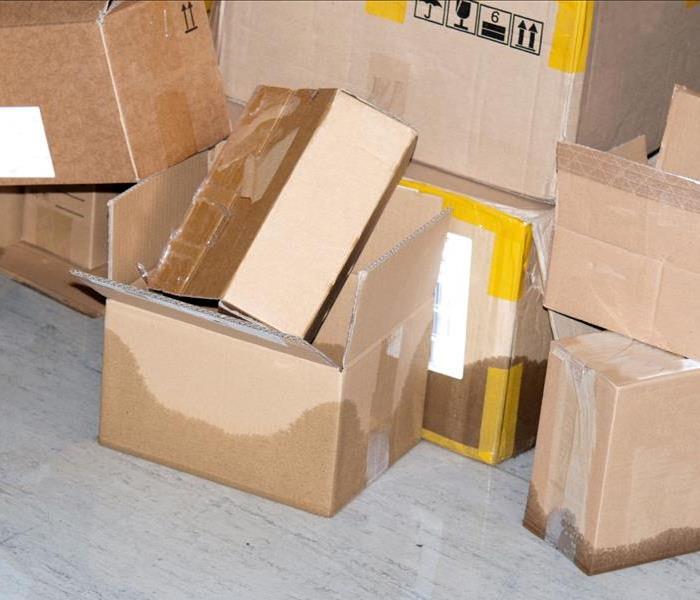 Storing your valuables in cardboard boxes on the basement floor is like asking for your belongings to be ruined. Instead try plastic totes
Storing your valuables in cardboard boxes on the basement floor is like asking for your belongings to be ruined. Instead try plastic totes
If water finds its way into your home, which in the Mid Ohio Valley seems to be inevitable after this past summer, you want to make sure you take extra steps to make sure your belongings are protected.
Something you will want to remember when putting items in your basement is to make sure they are at least a minimum of 6" off the ground. Avoid using cardboard boxes when you possible as they can absorb and hold moister just from the air. Instead one thing you can do is use plastic totes to place your items in. They may cost more, but in the long run they offer an added level of protection that will keep your more prized possessions or cherished memories safe.
A few other things to consider when protecting against water damage...
1) Make sure you clean your Sump Pump filter at least twice per year to ensure no debris has found its way in and the pump is working properly.
2) Clean your gutters and landscaping to promote proper drainage away from the house. Too much water running directly at the foundation of the home will lead to water finding its way in through cracks in the floor or walls of your basement.
3) If possible have a backup battery for your sump pump so if there is a power outage in a storm the pump can continue to run as necessary.
By following these simple steps you ensure that your home and valuables are protected from any water loss event.
But if the worst happens SERVPRO of Wood, Ritchie, & Pleasants Counties is here to help 24/7. Call 304-428-7378.
Faster to your Wood, Ritchie, & Pleasants Counties Water Damage Event
10/24/2018 (Permalink)
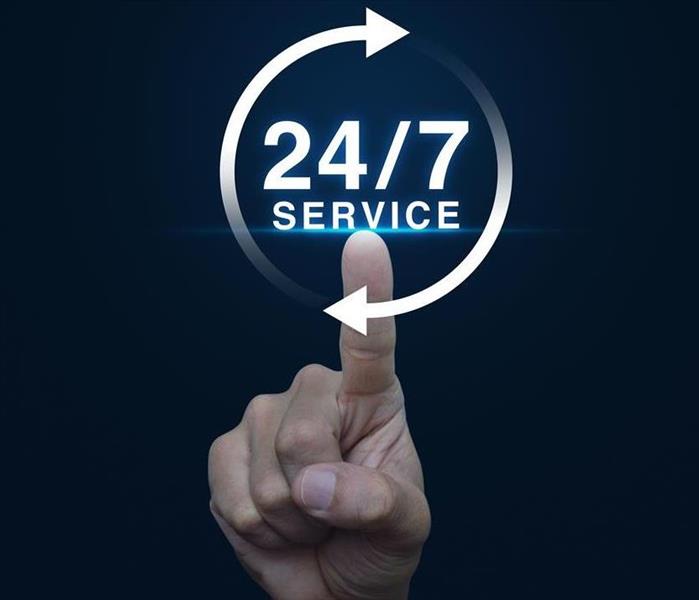 SERVPRO of Wood, Ritchie, & Pleasants Counties provides 24 hour fire and water damage restoration service in Wood, Ritchie, & Pleasants Counties.
SERVPRO of Wood, Ritchie, & Pleasants Counties provides 24 hour fire and water damage restoration service in Wood, Ritchie, & Pleasants Counties.
Flooding and water emergencies don’t wait for regular business hours and neither do we. SERVPRO of Wood, Ritchie, & Pleasants counties provides emergency cleaning and restoration services 24 hours a day, 7 days a week—including all holidays.
Faster To Any Size Disaster
Flooding and water damage is very invasive. Water quickly spreads throughout your home and gets absorbed into floors, walls, furniture, and more. SERVPRO of Wood, Ritchie, & Pleasants Counties arrives quickly and starts the water extraction process almost immediately. This immediate response helps to minimize the damage and the cleaning and restoration costs.
Need Emergency Service? Call Us 24/7 304-428-7378
Water Damage Timeline
Within Minutes
- Water quickly spreads throughout your property, saturating everything in its path.
- Water is absorbed into walls, floors, upholstery, and belongings.
- Furniture finishes may bleed, causing permanent staining on carpets.
- Photographs, books, and other paper goods start to swell and warp.
Hours 1 - 24:
- Drywall begins to swell and break down.
- Metal surfaces begin to tarnish.
- Furniture begins to swell and crack.
- Dyes and inks from cloth and paper goods spread and stain.
- A musty odor appears.
48 Hours to 1 Week:
- Mold and mildew may grow and spread.
- Doors, windows, and studs swell and warp.
- Metal begins to rust and corrode.
- Furniture warps and shows signs of mold.
- Paint begins to blister.
- Wood flooring swells and warps.
- Serious biohazard contamination is possible.
More Than 1 Week:
- Restoration time and cost increase dramatically; replacing contaminated materials and structural rebuilding may be extensive.
- Structural safety, mold growth, and biohazard contaminants pose serious risks to occupants.
About SERVPRO of Wood, Ritchie, & Pleasants Counties
SERVPRO of Wood, Ritchie, & Pleasants Counties specializes in the cleanup and restoration of residential and commercial property after a fire, smoke or water damage event. Our staff is highly trained in property damage restoration. From initial and ongoing training at SERVPRO’s corporate training facility to regular IICRC-industry certification, rest assured our staff is equipped with the knowledge to restore your property.
Mid Ohio Valley 24 Hour Emergency Water Damage Service
10/16/2018 (Permalink)
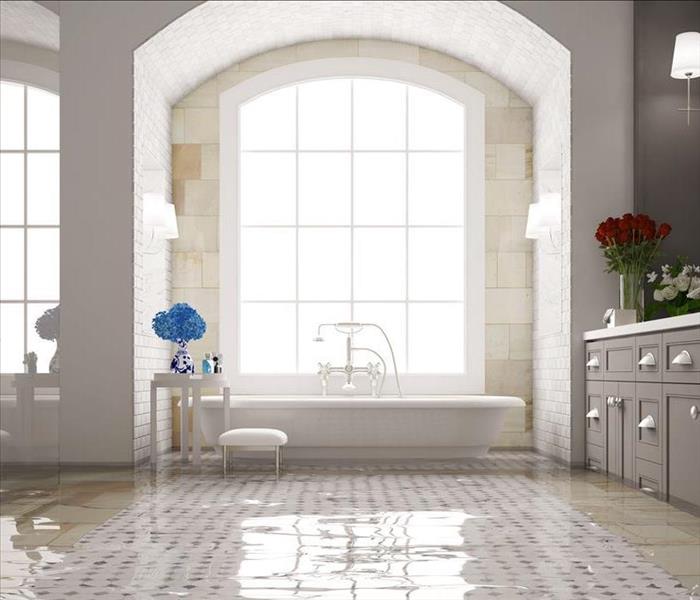 SERVPRO of Wood, Ritchie & Pleasants Couties provides 24 hour fire and water damage restoration service in the Mid Ohio Valley.
SERVPRO of Wood, Ritchie & Pleasants Couties provides 24 hour fire and water damage restoration service in the Mid Ohio Valley.
SERVPRO of Wood, Ritchie, & Pleasants Counties is available 24 hours a day for water emergencies, large or small. When you are dealing with water damage, immediate action is crucial. A delay of just a few hours can greatly increase the severity of the water damage.
We Answer the Phone Ready to Help
Call Today 304-428-7378
We understand that when you call us, you may be feeling confused, stressed, and vulnerable. You need an expert to guide you through this crisis. SERVPRO of Wood, Ritchie, & Pleasants Counties has the specific water damage training and experience to help you through this tough time. We specialize in water damage restoration—in fact, it's the cornerstone of our business.
What to Expect
When you call, we will ask several questions regarding your water damage emergency. These questions will help us determine what equipment and resources to bring, including how many trained SERVPRO Professionals may be needed.
Our SERVPRO Representative will ask several questions:
- Your name and contact information
- Your insurance information (if applicable)
- The street address of the water-damaged home or business
- When did the flooding or water damage occur?
- What caused the water damage (if known)?
- Is there electricity available (on-site)?
About SERVPRO of Wood, Ritchie, & Pleasants Counties
SERVPRO of Wood, Ritchie, & Pleasants Counties specializes in the cleanup and restoration of residential and commercial property after a fire, smoke or water damage event. Our staff is highly trained in property damage restoration. From initial and ongoing training at SERVPRO’s corporate training facility to regular IICRC-industry certification, rest assured our staff is equipped with the knowledge to restore your property.





 24/7 Emergency Service
24/7 Emergency Service

